With the demand for new homes ever increasing, we ask what will the buildings of the future be like? Will new materials like bamboo or plastic take a bigger place in our houses? And how can we make our accommodation greener? Plus, in the news, the first model of all of Earth's ecosystems, what a 115 year old can tell us about aging, how to improve cochlear implants, and what happens if you try and stowaway on a plane...
In this episode

00:54 - The Madingley Ecosystem Model
The Madingley Ecosystem Model
with Mike Harfoot, United Nations Environment Programme-World Conservation Monitoring Centre
This week, scientists from Cambridge have unveiled a way to model on a computer,  how Earth's different ecosystems, the networks of plants and animals that depend upon each other, actually work.
how Earth's different ecosystems, the networks of plants and animals that depend upon each other, actually work.
This will enable researchers to understand better how human activities are likely to influence the world around us, and how to better conserve what we have.
Mike Harfoot is one of the creators of the system and he's based at the United Nations Environment Programme-World Conservation Monitoring Centre in Cambridge and also, Microsoft Research in Cambridge
Chris - First of all, one question, one word - why?
Mike - Yeah, so I think you can separate that into two components really, you hit the nail on the head in your introduction. So until now, or essentially, at the present, we have a very limited ability to be able to predict the future of the living Earth, and therefore, to understand the consequences of the human actions in the present and how they might affect the biological world in the future. Another component to that is there is more of an academic one, but really, it's interesting to know, is it at all possible. Can we predict the biological world and what parts of it can and can't we predict?
Chris - How have you gone about doing this?
Mike - We've taken a relatively novel approach in that we're trying to model every different type of organism on Earth and model them at the level of the individual. So, how that individual feeds, reproduces, why it dies, and how it moves around the environment. So, we have lots and lots of different types of these organisms that essentially we throw into the model, and we allow them to run around interacting, eating each other and running away from each other. And then we're interested in - when you do all that, the properties of those collections of organisms, how do they compare to the real world really.
Chris - Essentially, you have a field with grass, you put cows in the field with grass, you then put humans in and they farm the cows. They eat the cows, the cows having eaten the grass. There are bugs living in the cows. And so, you build up this sort of layers and layers of things living on and in, and around each other and depending on each other.
Mike - That's right. I guess my caveat to that would be that we don't have any humans in there at the minute, which is relatively important in the present day. So, we're really modelling I guess a pristine world without human influence. But you're right. We have plants and then we have small organisms that might eating the plants and then large organism might be eating those.
Chris - Do we know enough about all of those relationships in order to build an accurate model?
Mike - I think that's the interesting thing, that actually, the field of ecology knows quite a lot about different parts of it. So, we know an awful lot about how fast organisms of different sizes burn energy essentially to survive. We know quite a lot about how different organisms move around their environment in order to find prey - be that plant or animal species - and how fast they can eat those organisms.
So, we know quite a lot I think of fundamental facts about ecology. What we've been trying to do is encode all that into our model. There's another question which is, having put all that together, how do we know if what we predict looks like the real world. And that, we've found a bit more challenging. So, in our paper that was published this week. We pulled together essentially as much data as we could find on properties of the organisms and the collections of organisms that we predict in the model; be that at the level of individuals. So, how fast those individuals are growing in the model, how fast they're dying or reproducing. But then equally, when we look at those collections of organisms in a particular place, how many of those organisms are very small and how many are very large. So, we have a certain amount of information from the real world on that kind of stuff and broadly, the model recreates those patterns.
Chris - So, this is validating the model. It's saying, "Let's take real world data. Let's give the same problem to our model and see if it arrives at a solution resembling the real world. If it does, we must be doing something right."
Mike - Indeed, yes. I guess what we've done today is relatively crude in terms of the form of methods of evaluation and that partly reflects the amount of data that we can get, and also, the stage of the model. But yes, broadly speaking, we evaluated the model and it looks like it's a feasible way forward which is quite exciting.
Chris - The fact you haven't put the humans in, is that going to be the next step then so that you can then begin to ask things like, "I want to build a housing estate here. What influence is that going to have on the local ecosystem?"
Mike - Indeed, yes. So, I think there's a sort of many fold sets of research that derive from I guess where we are now with a proof of concept that the framework might work. One of which as you've eluded to is much more rigorously evaluating what it can and can't do. Another one is definitely including humans or the impact of humans and evaluating, so, what might the future hold, given that we've got a model now to predict it. And that might be at a small scale as you say, sort of a housing estate level. It might be a large scale, so, what happens if fisheries lead to a collapse of fish production in the world? What does that mean for how much food we need to grow on land and where we might do that without collapsing terrestrial ecosystems at the same time?

05:57 - Plane Stowaway
Plane Stowaway
This week, a teenage boy survived the 5 hour flight from California to Hawaii,  hidden in the wheel well of a plane. Experts are astonished that he seems to be unharmed- but just how amazing is his survival? Here are Kate Lamble and Dave Ansell with your quick fire science about travelling as an aeroplane stowaway:
hidden in the wheel well of a plane. Experts are astonished that he seems to be unharmed- but just how amazing is his survival? Here are Kate Lamble and Dave Ansell with your quick fire science about travelling as an aeroplane stowaway:
· - At ground level, the air we breathe is 21% oxygen. As you climb higher, this percentage doesn't change, but the reduction in air pressure means there is less air, and so less oxygen available.
· - Long haul flights can reach heights of over 30,000 feet. At this height, air pressure is so low that there is only a third of the amount of oxygen available than is available at sea level.
· - The reduced pressure also makes it harder for the oxygen to pass through the membranes of the lungs and into the blood stream.
· - As low as 10,000 feet, hypoxia can set in because of a lack of oxygen. This leads to dizziness, light headedness, and eventually loss of consciousness.
· - As well as reduced oxygen, the stowaway would have had to contend with temperatures as low as -62 degrees Celsius.
· - Hypothermia occurs when body temperature drops below 35 degrees celcius. Initial symptoms are shivering and confusion and in some cases it can lead to death.
· - However, hypothermia can be protective, as it slows down the metabolism, meaning you can survive with less oxygen.
· - Sometimes, hypothermia is even induced in patients suffering hypoxia after something like a stroke.
· - It may be that the stowaway entered a kind of 'hibernation' state, reducing his metabolism and so his need for oxygen, and allowing him to survive.
· - Although this time, the stowaway survived, others have not been so lucky. In fact, only a quarter of attempts are thought to be successful.
· - Even if you survive the majority of the flight, most people will be unconscious by the time the landing gear is deployed, so will fall out of the plane when it is still hundreds of feet up.
· - The number of failed attempts may be even higher than recorded, as many people may have fallen into oceans, and never been found.
· - However, there may also be unrecorded successful attempts, if the survivor escaped the airport without being detected.

09:07 - Improving cochlear impants
Improving cochlear impants
with Gary Housley, University of New South Wales
Cochlear implants are electrical devices that consist of a system of tiny 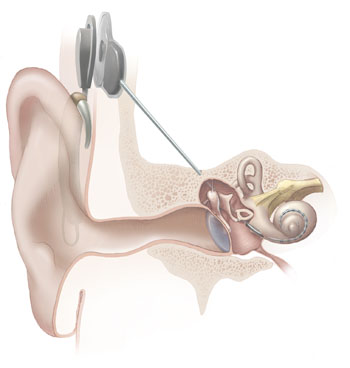 implantable electrodes that can directly activate "hearing nerves" in the inner ear or "cochlea" to treat deafness.
implantable electrodes that can directly activate "hearing nerves" in the inner ear or "cochlea" to treat deafness.
But only a restricted set of sounds can be signalled this way because the nerves are difficult to activate.
Now, University of New South Wales scientist Gary Housley and his colleagues have found that electricity from the cochlear implant can be used to make cells in the inner ear pick up short pieces of DNA coding for a gene for a nerve growth signal, called BDNF that can be injected into the ear.
This, in turn, makes the hearing nerves grow and become much more sensitive to signals from the cochlear implant, with the potential to dramatically improve the quality of the hearing experience.
Gary - The cochlea or our hearing organ converts sounds of different frequencies into information that's encoded in the auditory nerve fibres which then transmit that information to the auditory processing centres in the brain. There are about 4,000 cells called hair cells and they have these little hair-like processes on the tops of them and they respond to the vibrations produced by sound and release neurotransmitter that stimulates the auditory neurons.
Chris - And when a person goes deaf, what's gone wrong with the cochlea structure in those people?
Gary - Typically, it's the hair cells that are the most vulnerable. When the hair cells are lost, then in fact, the cells around them also seem to die. With that, they stop the production of, if you like, a hormone or a chemical that sustains the auditory nerve fibres then the auditory nerve fibre dies back. That's the state that the cochlea lies in if you like, at the point where people become severely hearing impaired and perhaps, a cochlear implant might provide a possible means of restoring a degree of hearing to those people.
Chris - When someone has a cochlear implant fitted, how does it work to restore hearing to those areas that have become hard of hearing?
Gary - A cochlear implant typically consists of 22 or fewer electrodes. What they do is by passing current from those electrodes out through the cochlea tissue, they're able to electrically stimulate and excite those auditory neurons. When those neurons fire their action potentials again, people can actually perceive sound.
Chris - So, how have you sought to improve the situation?
Gary - Well, we have tried to find the means to regenerate those auditory neurons, get the nerve fibres to a point where they're much more easily stimulated and therefore, give a broader and richer hearing experience.
Chris - How do you think you can do that?
Gary - Through gene therapy, it's possible to get cells to synthesise and release nerve maintenance factors - the neurotrophins - that have been lost when the hair cells died if you like. We use the cochlear implant to provide very short electrical pulses which were effective in actually driving the DNA into cells that were very close to the electrodes to make the nerve fibres head to those electrodes.
Chris - How do you get the DNA for the growth factor into the area in the cochlea where you want to use the electricity from the cochlear implant to get it into the adjacent cells?
Gary - We produce the DNA which codes for the sprain derived neurotrophic factor and we're able to inject that into the cochlea and then we pass the few electrical pulses and literally, within 5 seconds, we've been able to create small pores in cells that are very close to the electrodes. They take up the DNA and then in short order, they start producing the neurotrophin and within a few days, the auditory nerve fibres are growing back out and towards the electrodes.
Chris - Is this a permanent change or is this just temporary, this nerve response?
Gary - Using imaging techniques, we could see these new outgrowths for up to 3 months after our gene therapy. But by the time we'd gone out to 12 weeks, there were far fewer of these nerve fibres. So, what is clear to us at the moment is that, the expression is waning. So, this certainly would something we would want to look at and potentially find a means of sustaining the gene therapy for a longer period of time.
Chris - If you make measurements after these nerve cells have grown in this way in response to the nerve growth factor that you've expressed, does this translate into more sensitive hearing in your experiments?
Gary - Well, I think that was the really exciting point. With the regeneration that we achieved, we're able to then make a functional assessment of potential for improved hearing. The technique that we used for that is very similar to the technique that's used very broadly for newborn baby screening. It's called auditory brain stem response. We passed small currents through the cochlear implant, gradually step-up the amount of current that we're passing until, we're able to record a brainwave. With our gene therapy, we established that much smaller currents could be used to elicit a response. And then as we increase the amount of current, we got progressively greater increase in the output in those auditory centres in the brain.
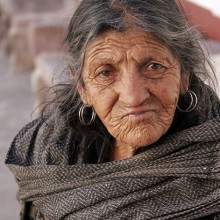
15:28 - Living to 115
Living to 115
with Henne Holstege, VU University Medical Center
You might have heard of mutations - which are effectively genetic spelling mistakes 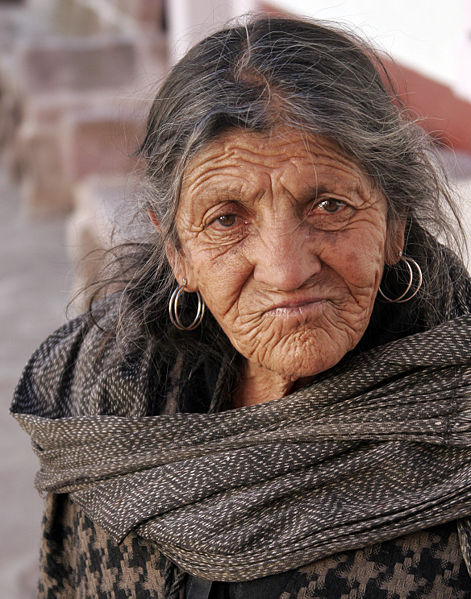 in DNA that crop up as we age - as being the cause of diseases like cancer. But are these errors always bad for us?
in DNA that crop up as we age - as being the cause of diseases like cancer. But are these errors always bad for us?
This week, scientists in Amsterdam have been looking at the blood of a 115 year old woman to see what her genes can tell us about living longer. Ginny Smith spoke to Henne Holstege from the VU University Medical Center in Amsterdam who led the study.
Ginny - Now, 115 years was pretty impressive. Was the woman still healthy at that age?
Henne - Well, at that time, she had a gastric tumour and that's actually what she died of. But her blood cells were still very healthy.
Ginny - That was what you were looking at - her blood cells. So, what did you find?
Henne - Well actually, what we found is that her blood cells had many mutations, 450 in a non-repetitive genome. The fractions of blood cells that had this mutations were such that it could only be possible that they were derived from only two stem cells. One of which was actually derived from the other, and that, we did not expect to find.
Ginny - So, what's the case in a young person for example? How many stem cells would their blood cells be derived from?
Henne - Well, it is estimated that everybody is born with about 20,000 blood stem cells over which about a thousand are active simultaneously. So, 2 then is a very, very limited number.
Ginny - But she was still okay even though she only had this two. What do we think was going on there?
Henne - Well, it could be that during our ageing, the amount of stem cells really decreases enormously. And so, what happens if she would've grown older if she would've not have died from this gastric tumour, what would have happened then if she would've had only 1 stem cell or having no stem cells is not united with life. So, what would that mean?
Ginny - So, what does this tell us about ageing and what might cause that process?
Henne - Well, we don't really know what exactly happens to all the other stem cells. It could be that they are inactive or senescent. We have no idea, but we did see that the telomeres had shortened extremely compared to all the other tissues that we tested.
Ginny - Can you explain to me what exactly telomeres are and why they're important?
Henne - So, telomeres are at the end of each chromosome and with every division of each cell, the telomeres shorten and it's been found that when they get short to a certain limit that the cell that has these telomeres or shortest telomeres will die. So, it could be that the stem cells have had so many divisions that they could not live any longer and died. But we don't know that is actually the case. We do know that they were very short though, the telomeres.
Ginny - So, you talked about this woman having 450 mutations. That sounds like a lot. How do you know that she wasn't just born with them?
Henne - Well, we tested her blood cells and we compared that with the brain cells and the brain cells hardly divide after birth and the blood cells, obviously, they had to supply all the blood cells. So, the blood stem cells had had many divisions after birth. So, what we did is we used the brain cells as a proxy for her genome during birth and then we compared that with the blood cells. And those changes are what we counted.
Ginny - Okay and what do you think the next step is? I mean, this was done on one woman. Are you looking for other people who are 115 to do the same sort of process on?
Henne - Well, 115 is a pretty peculiar age to get, so we are looking at other people with extreme ages and we are trying to find the same thing.
Ginny - And we're hoping that this maybe one day will give us the elixir of youth.
Henne - Well, I mean, lots of research is necessary to do that, but yes, it could be that this an extremely important part of - if there's no telomeres left or if all stem cell are inactive then that may be a bit of a difficult thing to live with so, yeah.
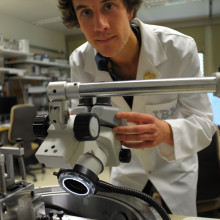
20:05 - World's Smallest Magazine Cover
World's Smallest Magazine Cover
with Colin Rawlings, IBM
This week researchers in Switzerland have created the smallest magazine cover in 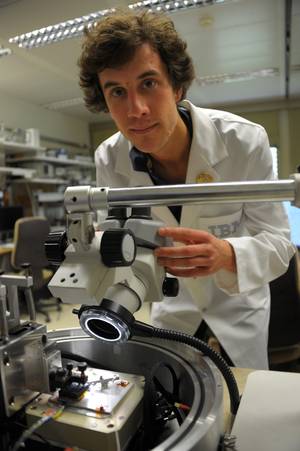 the world, using a tiny chisel to create an image so minute that 2,000 of them could fit on a grain of salt.
the world, using a tiny chisel to create an image so minute that 2,000 of them could fit on a grain of salt.
Colin Rawlings is one of the researchers behind the work...
Chris - The number one question must be, why on Earth have you done this?
Colin - Well, it sort of seemed like a fun thing to do, but also more generally, it was the work done with National Geographic, the guys that supplied the cover and they were looking for a way to sort of show kids that you could do surprising and weird things with science. So, at IBM we were pretty happy to get involved in that.
Chris - IBM has something of a rep for doing things with very small things. I remember iconically the spelling of IBM in xenon atoms about 25, 30 years ago, made lots of magazine covers then. Actually, how did you do this though? How did you actually make these tiny images?
Colin - It's actually related sort of to that work that Don Eigler did, I think that we use a very sharp tip and we start with a flat plastic layer. And then by applying or heating up the tip and then pushing it into the surface, we cause the plastic to evaporate and so we're left them with a sort of a hole in the area that we touched down on. Then if you scan over the surface making holes of the correct depth at each point, what you're left with is a sort of 3D topography of hills and valleys that if you do it correctly, it can look like a magazine cover or indeed, anything else that you want it to resemble.
Chris - So, the magazine cover is a slightly trivial application, but makes the point. Obviously, makes you very news worthy, but the point being that you could use the same technique then to make any kind of 3 dimensional microstructure, very tiny structures that you would need or have some kind of function for.
Colin - Yeah, exactly, that's right. So, as the technique gets more mature, that's sort of the processes, or sort of the way we try and go with this and there are things that you can do with 3D structures that it's hard to do with the sort of 2D structures that you can make with traditional techniques.
Chris - What sorts of things are you going to make?
Colin - So, there's now one effort that if you can focus light to a high enough degree then you can get interesting quantum effects that otherwise wouldn't be possible. So, that's something that - a paper that came out I think a year or two ago showing this theoretically and now, we try and make the experimental validation of this.
Chris - Why is this any better than what we can already do with what's dubbed "photo lithography" where we etch bits of silicon to make microchips which must be on the same sort of scale or smaller than what you are achieving here?
Colin - Yeah, exactly. In mean, the scale that we can do this on is actually a little bit better than you can do with optical lithography. Of course, where we lose its speed that it takes us much longer because we have to do it point by point. But I think the key difference is, firstly, that you can see what you've done straightaway. So, for scientists who are a bit error prone, this is a pretty nice thing that you can save for yourself a lot of time because you can directly see that you've made a mistake and then have another go. The other thing that we can do is this 3D patterning thing. That instead of writing one 2D shape that you can maybe extrude or stretch out the surface by or etch down into the surface, we can really make a 3D profile...
Chris - Can you also do this with more materials than just the traditional ways of etching microchips with silicon?
Colin - No. I think probably in the end, we're still making a shape and then we still use etching to transfer the shape from the plastic into another material or to apply metal to sort of control where metal is deposited or when dopants be controlled. So, in that sense, it works along the same lines.
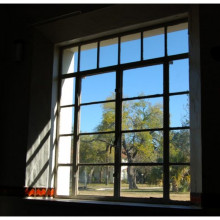
24:26 - Breathing Buildings
Breathing Buildings
with Shaun Fitzgerald, Breathing Buildings
As the need for new houses is hardly ever out of the news, we thought we'd look at 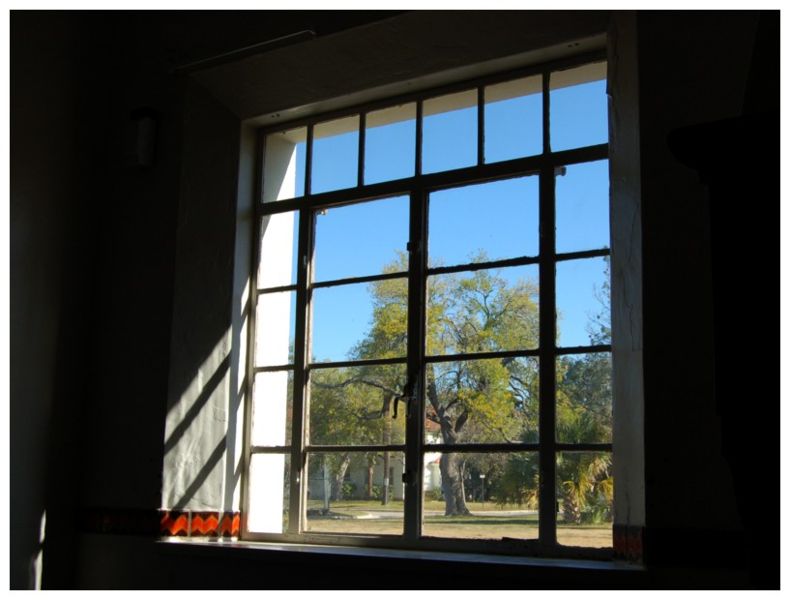 how our homes will change over the coming years.
how our homes will change over the coming years.
At this time of year, people have the window open, because it's a bit stuffy at home, but they still have the heating on. Shaun Fitzgerald is the managing director of breathing buildings, a Cambridge company who've come up with a way to much more efficiently ventilate our homes.
Ginny - Now, to kick us off, one thing that can be a bit of a problem at this time of year as the sun starts coming out is that it starts getting a bit stuffy at home and you think, "Oh, maybe I'll open a window." But then it's actually really still quite cold outside. So, you end up with this sort of debate in your head about whether you want to put the heating on or open the windows. Well, Shaun Fitzgerald is the managing director of Breathing Buildings, a Cambridge company who've come up with a way to, much more efficiently, ventilate our homes. Apart from the fact that it's a bit of a waste if people open their windows and have the heating on, what's wrong with just opening your windows when it gets a bit stuffy?
Shaun - Well, we all have a problem. If we're sat by the window, that if it's chilly outside, pity the poor granny who's sat next to that window. They're going to be subjected to an unpleasant cold draft. It really is just a local thermal comfort issue because what we have identified through the research that we undertook at the University of Cambridge is that in many buildings, after they have been well-insulated, which is just in accord with building regulations, the heat gains within the space. And maybe even solar gain on a beautiful day like today, there's plenty of it, the gains within the space is significant. So, if you wanted to have a plentiful supply of fresh air, if you do the maths as it were, you would quickly find out that there's enough heat in the building to manage your thermal comfort. But the granny has got a problem right next to the window. And therefore, it's a cold draft problem not a shortage of energy problem.
Ginny - So, the person by the window is getting a cold draft that someone who's a bit further away from the window may be still feeling hot and stuffy. So, how does your system work to sort of even that out?
Shaun - The concept that we came up with at the university which we've now put into a product and announced sort of selling it across the UK, and beginning to sell in the US as well, is a simple system that allows the air to exchange naturally between the exterior and the interior in crude terms you could say, isn't that what a window is. But the extra thing that we do is that we mitigate the cold draft by making sure that the incoming cold air is simply mixed with enough of that room air before that cold air now pre-warmed, hits granny. We've cured the cold draft and we use fan often to do that. but if it's efficiently tall space, we won't even use fans. We'll just calculate how high the vents need to be so that by the time the air has plummeted down as a turbulent plume, it doesn't create a cold draft. And it allows us to then not use energy-hungry mechanical fans which have been the previous way of curing the cold draft problem and that's really been the Achilles heel of ventilation and buildings than massive amounts of fan power being used.
Ginny - So, does this mean you have to design your house with this in mind? Do you have to change the way houses are being built?
Shaun - If we broaden the topic and say actually, buildings in general, then yes, it does. Not because of necessarily the winter issue, but if you want to try and get away from using fans to distribute air throughout the year, everybody within a building needs to be within reasonable proximity of an outside wall, a roof or a big atrium. So, it's really the architecture that is driving the building to be able to be able naturally ventilated by using principles where natural air flows within a building are limited depending on the floor to ceiling height and how far away from an external facade that you are.
Ginny - So, if you've got a big office building and you end up in an office that's right in the middle, then it's not really going to help.
Shaun - It's not and it's really important to identify that if that's the type of building that's being erected for good reasons for example if you're building in London where land is very expensive, you want to maximize the building area, you will end up typically with what we call 'deep planned buildings'. So, people in the middle of a building, multi-story, a million miles away from the external facade. Those buildings have to be mechanically ventilated. But when one looks at the building stock across the United Kingdom, not everybody is living in the middle of London. Most people actually live in areas where land isn't as expensive and buildings can be constructed and are being constructed which lend themselves very well to being naturally ventilated.
Ginny - And what kind of energy savings are we talking about here compared to a traditionally ventilated building?
Shaun - There was some lovely work done in the early '90s by a team at the University of Cambridge. And they identified that if you were to build a typical office building and ventilate it in a classical way, air-conditioning, mechanical ventilation and compare that with the building that had been designed so that it could be naturally ventilated, the energy savings were a factor of two. Now, not all of that is related to the savings in fan power. The savings have to do with, because everyone is now within reasonable proximity of an outside wall. They've got a greater possibility of being able to use natural daylight for a greater proportion of the year. So, you get lighting savings as well. But these buildings can save the energy by a factor of two. With our technology, we are seeing results where the energy savings are a further 50%. So, we're almost a factor of 4 in total we've seen.
Ginny - So, great news both for the environment and for the company. They're spending less.
Shaun - And for your energy bills indeed. So, it is a magnificent result. If you care about the energy story then green energy supply versus using less of it in the first place. Using less of it in the first place is a general rule for where you get a greater return on your investment.
Chris - You install in your office Shaun?
Shaun - We haven't installed it in our office. We lease our office and the office is an old building. We could go into the details, but if it's really old, it's already leaky and I don't need to worry about minimum air supply in the winter.
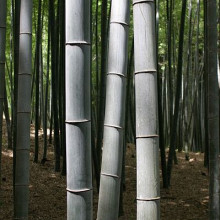
30:23 - Building with bamboo
Building with bamboo
with Michael Ramage, University of Cambridge
It's not just the way we build houses that might change in the future, but the materials we use as well. In order to make housing across the world more environmentally friendly Michael Ramage from the University of Cambridge is trying to develop the use of bamboo to replace traditional building materials. Chris Smith wanted to know why bamboo?
Michael - We're very interested in bamboo because it is very fast growing. It's widely distributed around the world, particularly in areas where populations are growing and populations are moving to cities, but also, where trees don't grow. And it's extremely strong.
Chris - What about the environmental equation, whereby, in the same way that people in America were growing a lot of crops to make biofuels, but actually, they were taking land that could be grown for food out of production. There was an environmental cost there focused at, to buy the food in from elsewhere or turn other land into food producing land to make up for the fact that we're growing fuel crops. Can we make the same sort of arguments for bamboo?
Michael - Well, if anyone has grown bamboo in a garden, they know that it grows rapidly and it tends to grow anywhere. The countries that grow a lot of bamboo like China or Columbia, we find it grows very well on hillsides, extremely steep hillsides where you can't plant crops.
Chris - So, why are people not doing this already?
Michael - There's a long history of using bamboo in its natural form for houses in vernacular cultures. So basically, people building without architects and it's only in the last 20 or 30 years that people have processed bamboo into the type of materials we use in conventional construction.
Chris - Well, tell us more. How do you process it because when I've seen bamboo use in China, you see scaffolding or buildings to extremely great heights made of bamboo? You think, "Gosh! That doesn't look very strong" but actually, it clearly is. How is it used differently then?
Michael - So, the processing of the bamboo is, it grows around. It's a stalk. It's a blade of grass that happens to be 17 centimetres in diameter. It gets split up into slivers which are then cut down into rectangles and then the rectangles are glued together to make big sheets of what we might refer to as plywood. It's a different material, but it's like a sheet of plywood.
Chris - What's its mechanical characteristics that mean it's better or at least equivalent to what we could otherwise use?
Michael - So, it's about 5 times stronger than timber in either tension or compression, so when you pull on it or push on it. Compared to its strength, it's extremely flexible. So, its flexibility is about the same as timber.
Chris - Gosh! These are good statistics. I can't understand why we're not all doing this already.
Michael - Well, the material is - although bamboo grows all over the world and there's a lot of the material and it grows extremely fast, there isn't a lot of bamboo that's processed. It's mostly processed for flooring as you probably have seen in buildings around Cambridge. It's quite popular.
Chris - It doesn't sound like it's rocket science to make those processed bamboo materials. You chop it up and glue it together which is what we're already doing for chipboard and things anyway, aren't we?
Michael - Yes, indeed, but one of the problems is that there is at the moment, very little market because engineers and architects don't necessarily have codes they can refer to for designing bamboo buildings. Without bamboo buildings being designed, companies are reluctant to make a lot of material that doesn't have a market.
Chris - So, how does it stack up in terms of where it could be deployed? What sorts of building applications could it have and will it save people money because all of this is going to come down to the bottom line? Is this going to end up costing them a load more? If so, they're not going to do it because they're going to pass it on to the customer and become uneconomically viable?
Michael - Well, we think in the research that we're doing at Cambridge University is, looking at how we can use this structural bamboo in large scale buildings. So, 6, 7, 8, 10-story buildings. At the moment, a building like that made of structural bamboo would be much more expensive than an equivalent in steel or concrete. But we think in the long term that it will become competitive especially if we change the way we price carbon.
Chris - Will this be mainly the cladding that the bamboo is used for or would you see it being used for all of the building so you could replace the steel frame or the timber frame, or whatever sort of building you're doing with some kind of bamboo composite?
Michael - The work we're doing at the moment is looking at ways to replace the structural frame with bamboo. There is already quite a bit of material that can be used for cladding, particularly the interior surfaces.
Chris - What about lifeing of the material? We know if you build a house from an oak frame, it'll be there in 500 years if you look after it. Do we know what the lifeing of these bamboo materials is?
Michael - The same is true for bamboo. If you keep it dry and keep it out of the sun and in other words, if the architects and the engineers detail the buildings correctly and they stay dry then it will last for a very long time, just like wood will.
Chris - Why is bamboo structurally sort of ultrastructural level so good in this regard? Why does it have these characteristics?
Michael - Well, we have partners at MIT who are working on that at the moment, but in simple terms, it's made up of very, very strong fibres that go in one direction up the stalk of bamboo. Those fibres themselves are extremely strong.
Chris - And so, if you cross them so they're at 90 degrees to each other when you stick the chips together then you're going to get this very, very powerful composite in two different directions just like plywood.
Michael - Yes and there are many ways you can put them together, either crossed or all oriented in the same way to get different sorts of properties, depending what you're trying to build.
Chris - Well, I might have to build my next house out of bamboo so the pig that built his house from straw was sort of halfway there. He's still using a sort of grass, wasn't he? Michael Ramage from the University of Cambridge, thank you very much.
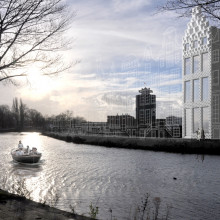
36:44 - 3D printing, one room at a time
3D printing, one room at a time
with Martine de Wit, DUS Architects
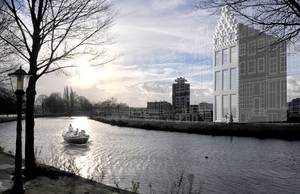 Ginny:: One team working on a huge change in how homes are built is DUS architects in Amsterdam and they're currently 3D printing a whole canal house, one room at a time. Martine de Wit is the co-founder of the practice. Your 3D printing house, I'm guessing you're not using a sort of normal 3D printer, the desktop things that I've seen before.
Ginny:: One team working on a huge change in how homes are built is DUS architects in Amsterdam and they're currently 3D printing a whole canal house, one room at a time. Martine de Wit is the co-founder of the practice. Your 3D printing house, I'm guessing you're not using a sort of normal 3D printer, the desktop things that I've seen before.
Martine - No, not really, but we actually upscaled. We upscaled a ultimaker which is a self-built 3D printers and we upscaled it to a size so we can now print 2 ½ and 2 ½ by 3 ½ meters high.
Ginny - Okay. What made you decide that 3D printing a house was a good idea?
Martine - Well, we had these desktop printers at the office and we were printing architectural scale models with them. While doing that, we thought, "Well, why not build a house at once without making the model?"
Ginny - So, most 3D printers I've seen use plastic to build their models. Is that what you're using?
Martine - Yes, that's what we use as well. But a little bit different sort of plastic.
Ginny - How exactly does it work? Do you print them out in layers?
Martine - Yes. It's exactly the same as the desktop printers. So, you really build it up layer by layer. So, it's the FTM technique as we call it and we use pellets instead of a filament and the pellets go into an extruder where it's melted and squeezed together to a homogenous liquid. And that goes to the nozzle which is programmed.
Ginny - How do you know that something like this is going to be structurally sound? I'd be a little bit nervous about getting into a house that was printed on a 3D printer.
Martine - I can imagine. No, we are testing that all. So, we have a lot of research and do projects within the project. One of them is the construction research, so we test by doing because there are no parameters of course to calculate with. So, we make test prints and those test print go into a scientific programme to get parameters to start making calculations for construction.
Ginny - How did you go about designing this house? This is something brand new. What made you decide to go for a canal house for example?
Martine - Okay, yeah. When we think about 3D printing then you can also think that you make something here, but you can print it all over the world. So, we really wanted to do something local, something that fits Amsterdam. But Amsterdam was always the inner circle was, you do the rings let's say, the canal belt. It's really a centre for innovation with the newest things we're showing off. Also, when you look at the canals, you see the houses, they're always kind of the same language, but they are really different. So, we thought that could be really nice example to make the 21st century canal house.
Ginny - And is this something you see as being in the future, this will be how everything is built?
Martine - I think so. At least it will be very common I think, and I don't think that we are going to print all the houses maybe. But I do think that lots of houses will be printed with the houses that are still built in traditional ways. The 3D printer will be just a tool next to a saw or a drill bit. It's really going to be a tool which is used to make a house.
Ginny - Now, we've been talking a lot about being green and being environmentally friendly. Building a whole house out of plastic doesn't sound very environmentally friendly to me.
Martine - Well, I think plastic can be also very environmentally friendly, but most of all, I think the environmentally friendly part of 3D printing is that you only transport the raw materials, so not the constructed parts. And also, you're only going to use the materials that you need for the object. So, there's no waste at all. The building is the biggest waste producer which we have at the moment. So, that's going to be a big difference and we are thinking of printing with recycled plastics, the plastic which are not in use anymore and then the fourth thing actually is that if you have something printed, you could shred it and use the material again.
Ginny - Good answer!

41:48 - Daylighting your house
Daylighting your house
with Christoph Reinhart, MIT
Arguably one of the most important considerations when designing new buildings is  energy efficiency; and a lot of that relates to how many lights need to be turned on to illuminate the interior. And as we build at higher densities, and try to meet strict thermal insulation requirements, architects are having to think even more creatively about how to make the maximum use of free lighting, in the form of natural daylight. From MIT, Christoph Reinhart...
energy efficiency; and a lot of that relates to how many lights need to be turned on to illuminate the interior. And as we build at higher densities, and try to meet strict thermal insulation requirements, architects are having to think even more creatively about how to make the maximum use of free lighting, in the form of natural daylight. From MIT, Christoph Reinhart...
Christoph - Daylight is an important concept not only for architecture but for really, everybody. If you think back before the times when we had electric lighting in building, really daylight was a necessity the only source of us being able to see what is going on in building. Why daylighting is important nowadays, has actually two reasons. Well first of all, it tends to provide a better type of lighting than electric lighting. It's because the colours of daylighting come out more vividly. When daylight shines on objects, you can see them better. Now, another benefit of daylighting is of course that if we have a room without a window then we have to turn on the electric light and that takes a lot of energy if we use the daylight that comes for free.
Chris - What about human physiological impact as well? Are humans better off under daylight than under artificial light?
Christoph - Yeah, it's very good that you're asking that question. So, we've known for a long time that visual rendering of objects are better with daylight because it comes in all colours of the rainbow. So, they render the colour of that object very well. Something else that's very exciting that we only found out really within the last decade is that daylight not only provides us visual information about the world around us, but it also is linked to something that's called our circadian rhythm, so our biological clock. What that concept means really is that all of us, in our brain, we have a little clock that tell us what time it is. If we wouldn't get any clues from the outside world, through light, what time it is, then we would start drifting. Some of us would have maybe 25-hour days, others would have 23-hour days. So daylight, it's very important in training us, basically keeping us all synchronised that we can all follow our lives at the same time.
Chris - But equally, is it possible to end up with too much daylight exposure if you're working in a building and care is not taken. Could you end up with over lighting of the interior?
Christoph - Well, absolutely. That can happen. So, architects and owners think, the more, the better. So, if we just open our buildings, have a fully glazed facade then we get more daylight and it's necessarily better. But that's actually not the case because once we have too much daylight and we want to read a book or do something on an electronic device such as an iPad or a computer, then we might be in situations where we can't see because there's too much light. Basically, what there is, is really too much contrast. That means if you are in a room that is partly very, very bright to sunlight and then when you look in the back of the room, it's very dark, then our eye cannot adapt, cannot take in this large range of brightness variances and that's called glare, that leads to discomfort.
Chris - So, do architects have mechanisms to predict how much light is going to penetrate into a building, what the likelihood of glare occurring is and therefore, how to mitigate it?
Christoph - There are methods in place. So, especially over the last couple of decades, we've had made in the architectural world a lot of advances in modelling buildings in a computer. So, it's as if we are putting a building into something like a computer game from the gaming industry and then we can model the light for a whole year that shines on the building. So, we have become very good at predicting how much light there is in buildings.
Chris - Equally, does the same apply when trying to get light into a building? So, formatting the interior correctly so that you can get as much light as possible as deep into your building structure as possible. So, it's not just the people who sit by the windows that are well lit.
Christoph - Yes, that's a very good question. What is very important is how high the upper edge of the window is. So, if you're in a space right now, you're looking at the window, you really want to have the distance between the floor and the upper edge of the window as high as possible. So then you can basically get away with a window that takes maybe a third or so of the whole facade, the rest is just wall. But if the window is like a band of light which is close enough to the ceiling that on the one hand it allows you to look outside, but also, it's high up. Then it penetrates light very deep into the space.
Chris - Now, we're talking here about individual buildings, but often developments occur as whole clusters of buildings. So, is there any way or any tools available for architects to be able to format whole cities even so that they make the maximum use of available light and they minimise their cooling bills, they minimise their heating bills in order to be as energy efficient and light efficient as possible?
Christoph - Legislation has been in place for a long time. Arguably, one of the first legislations in the field of access to light at the street level and then buildings comes from 1917. These were the ordinances in New York city that when all the skyscrapers were being built in Manhattan that stipulated how much offset buildings have to have from the street so that there's sufficient light both on the street level as well as on the buildings. And these were really what we would call section base. So, it's as if you draw in 2 dimension a city on a piece of paper, just the outline. You don't really think 3-dimensionally of the problem. You just see two buildings next to each other that form an urban canyon.
Nowadays, due to advances in computer rendering and just availability of data on cities, what we've been working on in our lab is an urban modelling platform called 'Umi' and what this allows is that we can effectively use data that are available for many cities which are called geographic information systems that contain information about the form, the shapes of any building in the city that usage pattern, the existence of trees around it, the value of the building and so forth. So, we can take these big databases and convert them into energy and lighting simulation programmes and scenes, run simulations of lighting and energy for whole city and then provide that back to the city. So, they can then use this information for example to have better policies of how much distance between buildings have to exist when you go away just from the daylighting and look more at energy use in buildings. We can then use this for policy measures to say, what are the most offending buildings in our neighbourhood that use too much energy? How can we help these buildings save energy for the whole city?
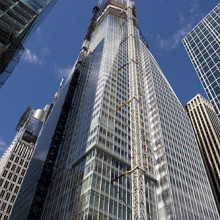
How high can buildings go?
Chris - Michael perhaps you could comment on bamboo. How high do you think it could build?
Michael Ramage - Well, we know we can build 10-storey buildings with wood and we've got proposals that are feasible for 30 stories in wood. So, with bamboo being somewhat stronger, I think 50 to 60 stories will be probably quite likely in the near term.
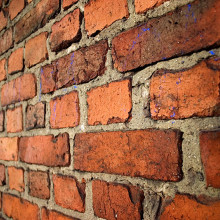
What do green walls do?
Shaun Fitzgerald - I think the topic of green materials for buildings is amazing because one of the challenges that we have in a building is assessing the embodied energy and how much energy or carbon was used to make materials. If you make it out of things like bamboo, it becomes a carbon sequester.

50:13 - Why do I feel tired and bored in the office?
Why do I feel tired and bored in the office?
Hannah - What's the scientific rationale for this? Dr. Tom Manly from the Cambridge cognition and brain sciences unit.
Tom - I think a broad assumption obviously is that the things that you're doing in the office are less interesting and less enjoyable than the things that you're choosing to do at the weekend. But I think with any task, we can see that there's a sort of dynamic interaction with the degree to which it captures the resources of the brain that are needed to do that task. So, if we're doing a task which is very interesting and salient, it's offering lots of stimulation that capture our attention. If you think about things like novelty, if it's very new that will tend to capture our attention, or if lots of very exciting things are happening very quickly.
Hannah - Frequent flurries of interesting, novel and salient tasks. Does that sound like your work? Perhaps Justin's work is more like this...
Tom - Watching paint dry, watching test cricket - all our effort is involved in monitoring whether our attention has moved onto the task, or has moved away from it and keeping it there. And that's what we experience as this subjective sense of effort. It's easy to see how some tasks that we do in the office would more easily fit into that category. We've done it many, many times before. It holds very little interest or excitement for us.
Hannah - And are there any differences between weekend activities and what you're up to at work?
Tom - Maybe how sensitive the task is to a lapse in attention. So, if you're in the office during the annual accounts, your attention may wander just for a moment, but the consequence of that is that everything will be out in the accounts and you'll have to start again. So, you'll really notice that lapse and attention whereas at the weekend maybe you're, I don't know, hovering, pottering around the house, you probably won't even notice if your attention has drifted from the task. It has no consequence. But the real key, if we're able achieve it and it's not always easy to achieve I realise is, if we want to pay attention very well during our work, then do something that you love. That's what makes it easy to pay attention.










Comments
Add a comment